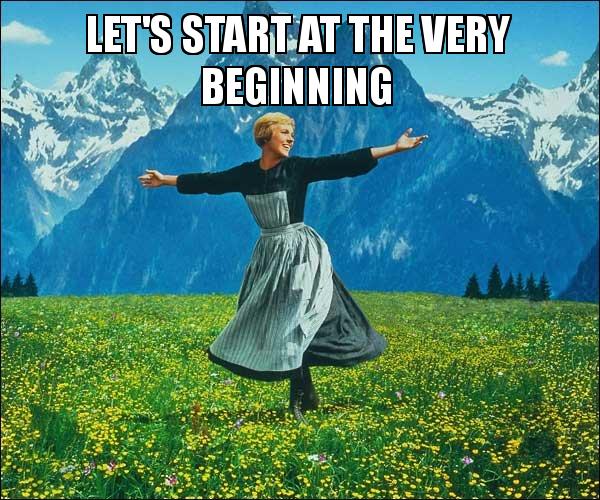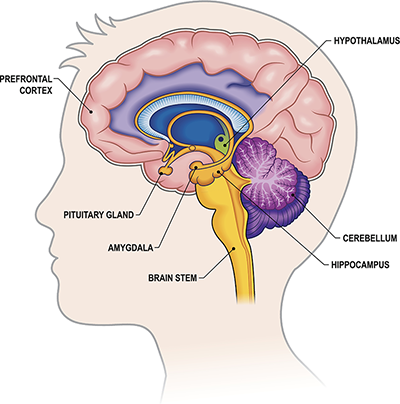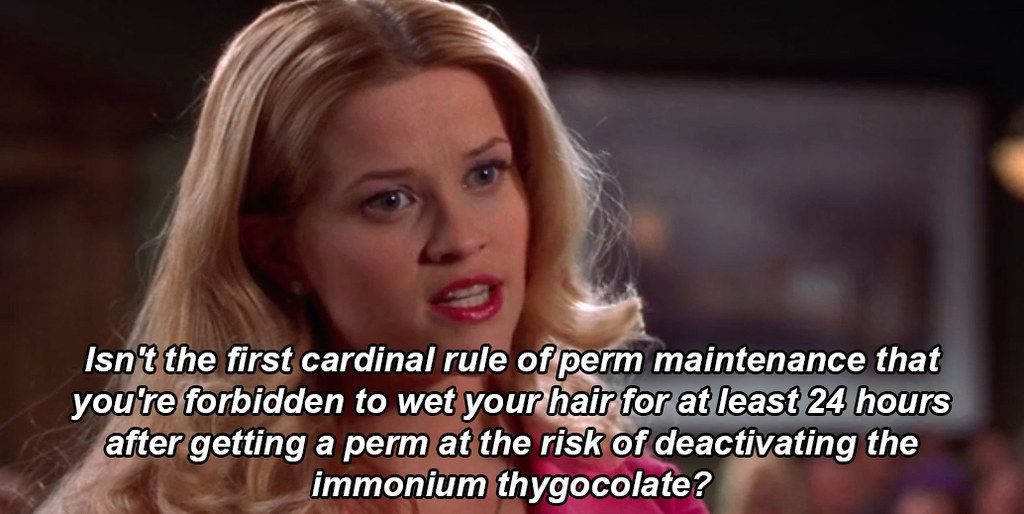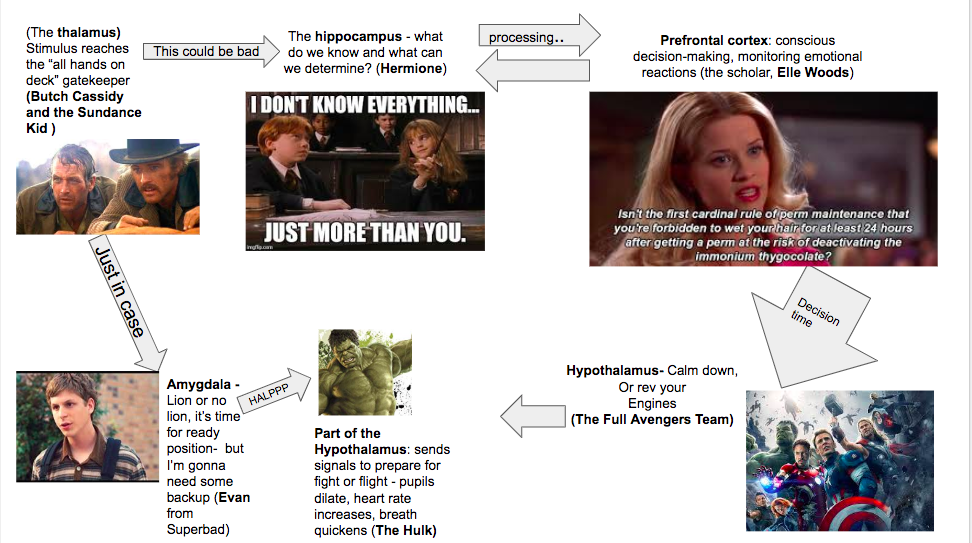Wrapping our heads around the brain
In the pursuit of tackling fear more frequently in our lives, a great first step is understanding the how and why behind this formidable factor. So we’re going to go straight to the source: the human brain, where it all begins.

The brain is beautiful, and it’s also complex. When I see a diagram of the human brain, first I think Well I guess the amygdala kiiiind of looks like an almond. And then after that I start to feel in over my head, so to speak.

So instead of trying to become neuroscientists overnight, we’re going to pretend that each part of the brain is a movie character. Because while the amygdala and the hippocampus may feel unfamiliar, nothing says “familiar” like movie references we grew up with.
Fear comes a-knockin’
First: Fear announces itself
The thalamus, aka Butch Cassidy and the Sundance Kid, registers a fear stimulus. Butch and Sundance Kid are the “All Hands on Deck gatekeepers.” Their job isn’t to analyze, it’s to detect. The dynamic duo from everyone’s favorite Western flick hears galloping and squints across the horizon, remarking “Who ARE those guys?”

Just like Butch and Sundance Kid poised behind the desert boulders with only a faint image getting closer, the thalamus only senses the stimulus. Its job isn’t to deem it “worthy of fear or no biggie.”
It senses the stimulus, and then sends it to two different operating systems: the amygdala, and the pre-frontal cortex.
Ring the Alarm
Second: The Amygdala takes its cue (and takes it very seriously)
The amygdala is Michael Cera’s character Evan in Superbad. It’s a rule-following adolescent who has always played by the rulebook, and their palms get real sweaty when they confront a risk. Their go-to is essentially panic, and they have 10,000 examples of people who they know who got into massive trouble by doing a similar thing. They are endearingly cautious. The implication of an imminent threat will send them spiraling. If they had a motto or a tag-line, it would be “Oh man. We’re going to die. We’re definitely going to die.”

The amygdala remembers fear, gets triggered by fear, and is the captain of preparing for worst case scenarios. It culls its database of fear memories to determine how recently a similar threat emerged and how scary it was. Evan immediately sends a cry to The Incredible Hulk (part, but not all of the hypothalamus), and BOOM: physiological responses to fear are activated. Pupils dilate, breathing accelerates, heart rate skyrockets. The body is ready for fight-or-flight.

Getting Reason on Our Side
Meanwhile….
While Evan is deciding which way to run and doing backward lunges to prime his leg muscles, the information from the fear stimulus is also being sent to the hippocampus and the pre-frontal cortex. This part of the brain is responsible for higher-level processing. The pro of this circuit is that it’s rational. The con of this circuit is that it takes longer to deliver a verdict. The amygdala is already texting their friends to take cover because something bad is on its way. But we need these processing systems in order to not be freaking out all the time.
The Hippocampus is Hermione. She knows all her spells from back to front and front to back, and stays cool as a cucumber under pressure. She is nurturing and has just the right amount of sass, and can always deliver the perfectly-timed eye roll. Another golden quality of Hermione? She’s loyal to her team. She doesn’t try to steal the show, but has no qualms correcting her peers that they’ve got something all wrong. ““It’s leviOsa, not levioSA!”

The Hippocampus is largely associated with memory. This makes it a key player in regulating emotional responses, and helping to determine what is worth getting highly concerned about, based on previous experience. Hermione is the MVP we need in our corner with her razor-sharp memory and keen ability to make informed decisions.
Teamwork makes the dream work
During this higher-level decision-making process, the hippocampus works closely with the prefrontal cortex to help process and analyze the threat.
The prefrontal cortex is Elle Woods, Harvard Edition. Determined as the day is long to prove her intellectual worth, she hits the books harder than Barry Bonds swinging a home run. No one’s going to stop her from getting to the bottom of a case. Not after Warner dumped her, saying he needs to marry “a Jackie not a Marilyn.” Not after the embarrassment of showing up as a playboy bunny to her law school party thinking it was a costume party. No one puts Baby– OR Elle Woods — in a corner.

With the same grit that brought Elle from pool parties in LA to being the valedictorian at Yale, the prefrontal cortex pulls out all its analytical and decision-making chops to determine what this threat is, where we’ve seen it before, and what response will really be necessary.
Elle Woods and Hermione have a good, long, chat at study hall, and together they arrive at a verdict.
Decision Time
The Avengers join the scene, because they’ve just noticed Evan doing lunges on the front lawn and The Hulk is tearing up fire hydrants. Understandably, they’re concerned that they need to do something before Evan has a meltdown and The Hulk escalates.
Here The FULL Avengers team represent hypothalamus in its entirety, a small-but-mighty region in the center of the brain. Just as The Avengers maintain order in the Universe, the hypothalamus maintains order in the body. This includes: releasing hormones, regulating body temperature, controlling physiological functions, and regulating emotional responses.

Finally, The Avengers take stock of what Elle and Hermione have decided, and then they determine their course of action. If the threat poses a real risk to your safety, The Avengers send a message to your body to maintain the physical states to appropriately respond to fear. They join the Hulk and flex their superpowers and whatever ensues depends entirely on the situation.
If the threat is deemed perfectly manageable, and a false alarm, The Avengers send a message to the parasympathetic nervous system, which acts like a brake. Your body then returns to its normal operating procedures, and The Avengers gently nod for The Hulk to put down the fire hydrant and come join them.
Two Systems, One You
As you’ll notice, when the brain detects fear, the information input is sent to two different avenues. First is the immediate fight-or-flight path, where physical sensations are triggered and engaged. Second is the analytical path, which takes a little bit longer to decide on the best course of action. The result of this dynamic? We feel fear in our body before we’re often able to decipher if the stimulus is worth being afraid of.
So what does this mean for us? It means that the more in tune we are with our minds and our bodies, the better we can respond to fear. If we can remain aware of our senses and how we’re experiencing different feelings in the body, we become better equipped to recognize fear when it shows up. When we become better equipped at recognizing fear, we can then become more adept at waiting for our brain to deliver us informed decisions for how we can respond to that fear rather than letting fear determine how we engage with the world.
In the mood for a movie now? So am I.

